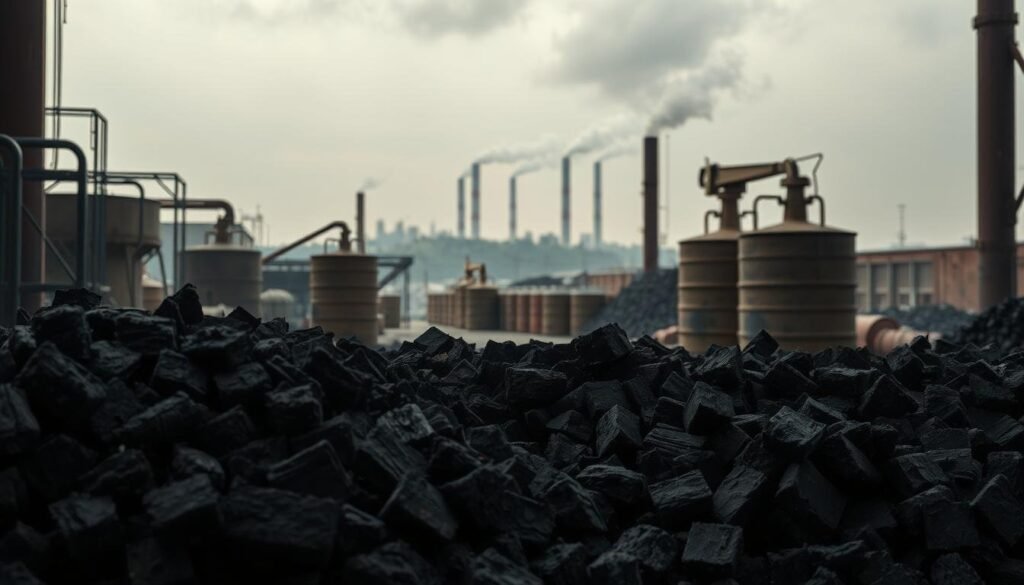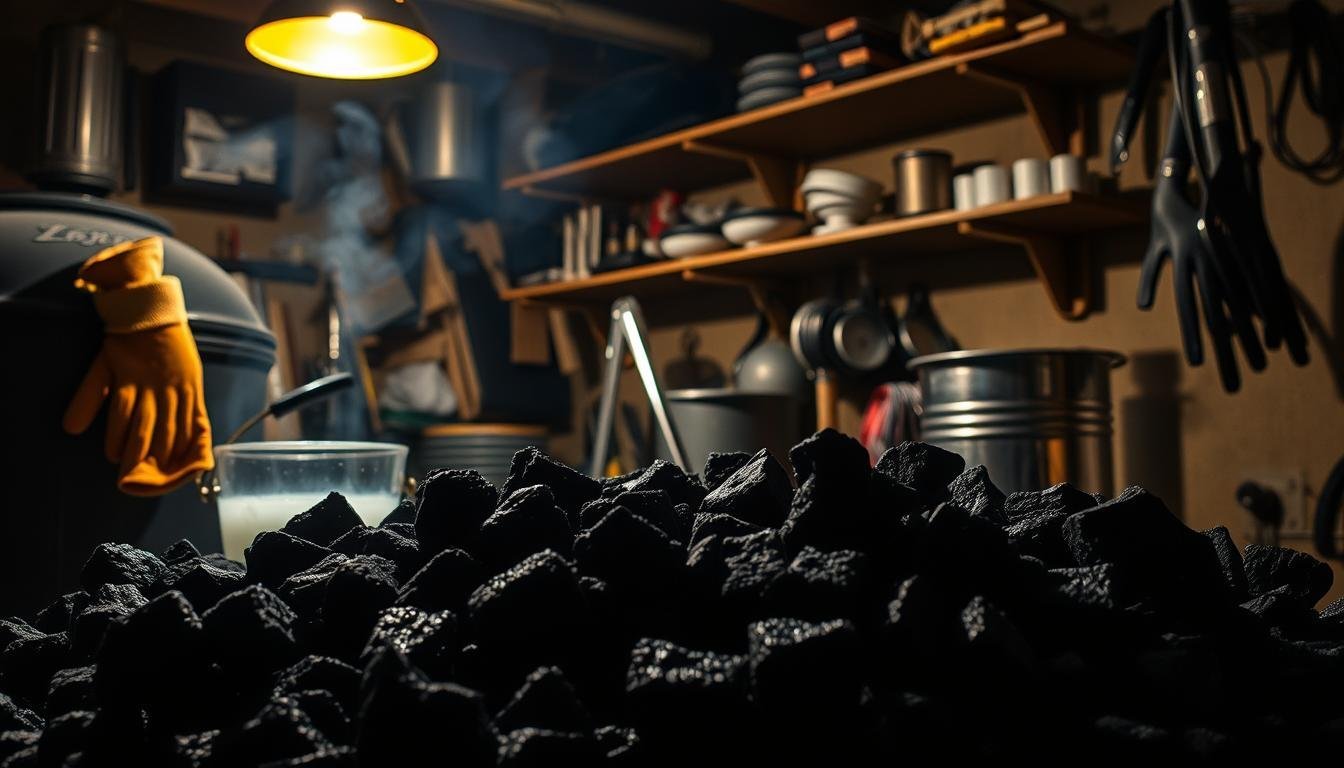Why Wet Charcoal is Dangerous? Using charcoal for cooking can be fun, but it has risks, especially when it’s wet. Wet charcoal can grow bacteria, making cooking unsafe.
Knowing the dangers of wet charcoal is key for safe grilling. If you’re not careful, you could risk your health and others. This article will teach you about the risks and how to stay safe.
By following simple rules for handling charcoal, you can avoid dangers. We’ll look at why charcoal safety matters and how to steer clear of wet charcoal risks.
Contents
- 1 Understanding Charcoal Basics
- 2 Why Is Wet Charcoal Dangerous
- 3 Signs Your Charcoal Has Become Wet
- 4 Common Causes of Wet Charcoal
- 5 Proper Charcoal Storage Techniques
- 6 What to Do If Your Charcoal Gets Wet
- 7 Emergency Fuel Options
- 8 Safety Precautions When Using Charcoal
- 9 Conclusion: Why Wet Charcoal is Dangerous?
- 10 FAQ
Understanding Charcoal Basics
Many people prefer charcoal for outdoor cooking because it offers a traditional grilling feel. Charcoal comes in different types, like briquettes and lump charcoal. Briquettes burn consistently, while lump charcoal gives a smoky taste.
It’s important to follow safety rules when working with charcoal. This means keeping it dry and using the right grilling methods.
| Type of Charcoal | Characteristics | Best Use |
|---|---|---|
| Briquettes | Consistent burn, uniform size | Long grilling sessions |
| Lump Charcoal | Natural, smoky flavor, irregular size | Grilling for flavor |
Knowing these basics is key for safe and effective charcoal use. It makes outdoor cooking more enjoyable.
Why Is Wet Charcoal Dangerous
Wet charcoal is dangerous because it can explode and release harmful gases. When it gets wet, it burns differently. This can make more carbon monoxide, a gas that’s deadly in closed spaces. So, it’s important to not use wet charcoal.
Wet charcoal can also cause a “charcoal flash.” This happens when the wet charcoal heats up and the water turns to steam. Then, the steam can ignite, leading to a dangerous flare-up. Such incidents can cause severe burns and injuries.
Also, wet charcoal makes more smoke and soot. This smoke not only ruins your cooking but also pollutes the air. It’s a problem for people with breathing issues.
To stay safe, keep charcoal dry and check it before using. If your charcoal is wet, replace it with dry charcoal. This ensures a safer cooking experience.
Knowing the dangers of wet charcoal helps you avoid them. This way, you can have a safer and more enjoyable grilling time.
Signs Your Charcoal Has Become Wet
Wet charcoal shows several signs. Its look and how it works change a lot when it gets wet.
One big sign of wet charcoal is if it looks clumpy or sticks together. Dry charcoal breaks apart easily. But wet charcoal clumps because of the moisture.
Also, if you see mold or mildew on the charcoal, it’s wet. A musty smell or visible mold means the charcoal has been affected by moisture.
To see if your charcoal is wet, just look at it. If it’s hard to light or doesn’t heat up well, it might be wet. Identifying wet charcoal early helps you avoid problems.
Common Causes of Wet Charcoal
Several factors can make charcoal wet. Knowing these can help you prevent it. One main cause is improper storage. If charcoal is stored in a damp place, it absorbs moisture and becomes wet.
Another big factor is rain. Leaving charcoal outside without a cover means rain can soak it. High humidity in the air also makes charcoal wet by absorbing moisture.

To avoid these problems, store charcoal in a dry, well-ventilated spot. Cover it when not using. By understanding why charcoal gets wet, you can keep it dry for your next grilling.
Proper Charcoal Storage Techniques
To keep your charcoal dry and effective, it’s crucial to implement proper storage techniques. You can significantly extend the shelf life of your charcoal by protecting it from moisture.
One effective method is using desiccants. Desiccants are materials that absorb moisture from the air, keeping your charcoal dry. You can place desiccant packets or silica gel near your stored charcoal to maintain a dry environment.
Using Desiccants
- Choose the right desiccant: Opt for desiccants that are designed for high-humidity environments.
- Replace desiccants regularly: Over time, desiccants lose their effectiveness, so make sure to replace them as needed.
Ventilation Considerations
Adequate ventilation is also vital. Store your charcoal in a well-ventilated area to prevent moisture buildup. Avoid storing charcoal in humid or enclosed spaces like basements or sheds without proper ventilation.
By implementing these charcoal storage tips, you can ensure your charcoal remains in good condition. Proper storage is a simple yet effective way to maintain the quality of your charcoal, ensuring it’s ready for your next grilling session.
What to Do If Your Charcoal Gets Wet
If your charcoal gets wet, don’t worry; there are ways to fix it. Wet charcoal can ruin your cooking plans. But, there are quick fixes and alternatives to help you.
One fast fix is to use dry kindling to dry the charcoal. This works if the charcoal isn’t too wet. You can also use propane or electricity if they’re nearby.
Emergency Fuel Options
Having backup fuel is key when charcoal gets wet. Some good alternatives include:
- Propane tanks for grills or stoves
- Electric grills or cooking appliances
- Dry firewood for a makeshift fire
| Emergency Fuel | Advantages | Disadvantages |
|---|---|---|
| Propane | Quick to heat up, easy to control | Requires propane tanks, can be expensive |
| Electric Grills | Easy to use, less mess | Limited portability, requires electricity |
| Dry Firewood | Portable, can be cost-effective | Requires skill to manage, can be messy |
Having these options can save your cooking plans. It’s smart to keep some emergency fuel with your charcoal. This way, you’re ready for any situation.
In short, wet charcoal is not the end of your cooking plans. With the right emergency fuel options, you can keep cooking without a hitch.
Safety Precautions When Using Charcoal
To have a safe and fun grilling time, it’s key to follow charcoal safety tips. Handling charcoal needs care because it can be dangerous if not done right. Always keep charcoal in a dry, well-ventilated spot, away from kids and pets.
When you grill with charcoal, make sure your grill is on a stable, heat-resistant surface. Keep it away from things that can catch fire. Never leave a lit grill alone, and have a fire extinguisher or a bucket of sand ready for emergencies.
To put out charcoal after you’re done, close the lid and vents to cut off oxygen. Let the charcoal cool down completely before throwing it away. You can also use water to put out the coals, but watch out for steam burns.
By following these barbecue safety tips and staying alert, you can lower the risks of using charcoal. Always be careful and ready when working with charcoal to have a safe and fun cooking time.
Conclusion: Why Wet Charcoal is Dangerous?
It’s important to know the dangers of wet charcoal for safe grilling. Recognizing wet charcoal signs and preventing it can lower risks. This makes your grilling safer.
Storing charcoal right is key. Keep it dry and in a well-ventilated spot. This keeps it safe and good to use. If your charcoal gets wet, knowing how to dry it or when to throw it away is crucial.
By following the safety tips in this article, you can have a safe and fun grilling time. Stay informed and proactive. Prioritize charcoal safety for a great outdoor cooking experience.
See Also: Why Are Robinson Helicopters So Dangerous?
FAQ
What are the risks of using wet charcoal?
Wet charcoal can cause explosions and release harmful gases. It also poses other safety risks. Knowing these dangers helps you stay safe.
How can I identify if my charcoal is wet?
Look for signs like clumping, mold, or a musty smell. Wet charcoal is often heavier and feels different to touch.
What are the common causes of charcoal becoming wet?
Charcoal gets wet from rain, high humidity, or bad storage. Knowing why it gets wet helps you prevent it.
How should I store charcoal to keep it dry?
Store charcoal in a dry, well-ventilated spot. Keep it away from sunlight and moisture. Using desiccants can also help.
Can I use wet charcoal for cooking?
No, it’s not safe to cook with wet charcoal. Instead, store and handle it properly to keep it dry.
How can I dry out wet charcoal?
It’s hard to dry wet charcoal completely. But, you can try spreading it out in a dry, well-ventilated area. Replacing it with dry charcoal is usually better.

Lorenzo Sloan is a safety advocate from Los Angeles who exposes hidden and everyday dangers through research-based blogging. With a background in social work, he aims to keep readers informed, cautious, and prepared for the unexpected risks around them.

